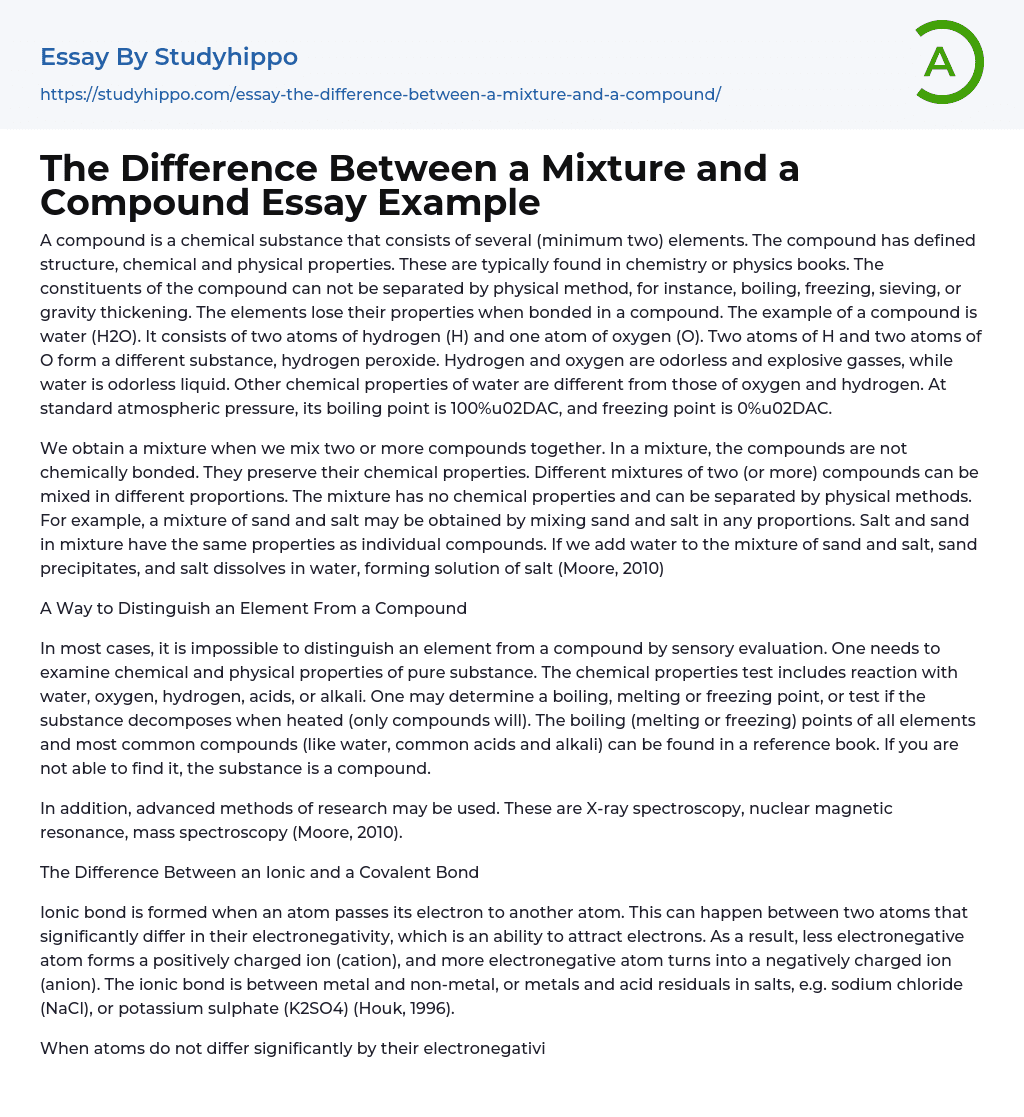

The Difference Between a Mixture and a Compound Essay Example
A compound is a chemical substance composed of at least two elements with specific physical and chemical properties. It has a defined structure and cannot be separated by physical methods like boiling, freezing, sieving, or gravity thickening. When elements combine to form a compound, they lose their individual properties. Water (H2O) is an example of a compound made up of two hydrogen atoms (H) and one oxygen atom (O). In contrast, hydrogen peroxide forms when two hydrogen atoms (H) combine with two oxygen atoms (O), resulting in a different substance. While hydrogen and oxygen are odorless gases that are explosive, water is an odorless liquid with distinct chemical properties such as its boiling point of 100°C and freezing point of 0°C under standard atmospheric pressure.
Mixtures, on the other hand, are created when multiple compounds are combined without any chemical bonding between them. Th
...ey retain their individual chemical properties and can be separated using physical methods. Unlike compounds, mixtures do not possess unique chemical properties. For instance, combining sand and salt in any desired ratio results in obtaining a mixture of sand and salt where the individual compounds maintain their original properties.When water is added, the sand will separate while the salt dissolves, creating a salt solution (Moore, 2010).
To distinguish between an element and a compound, one must analyze the chemical and physical characteristics of a pure substance. Chemical property tests involve reactions with water, oxygen, hydrogen, acids, or alkali. Additionally, boiling, melting, or freezing points can be determined or decomposition upon heating can be tested for (only compounds exhibit this). Reference books provide boiling (melting or freezing) points for all elements and common compounds. If
this information is not available, it is likely that the substance is a compound. Advanced research methods like X-ray spectroscopy, nuclear magnetic resonance,and mass spectroscopy can also be used (Moore 2010).
An ionic bond forms when an atom transfers its electron to another atom. This occurs between atoms with significantly different electronegativities - their ability to attract electrons.The less electronegative atom becomes a positively charged ion (cation), while the more electronegative atom becomes a negatively charged ion (anion). Ionic bonds are formed when metals react with non-metals or acid residuals in salts like sodium chloride(NaCl) and potassium sulfate (K2SO4) (Houk1996). On the other hand , covalent bonds are created between atoms with similar electronegativity as they share electrons.Covalent bonds usually occur between non-metals like H2O (water), NH3 (ammonia), and CO2 (carbon dioxide) (Houk, 1996). On the contrary, the formation of ionic compounds happens when a metal from the left side of the periodic table reacts with a nonmetal from the right side. Metals on the left have low electronegativity and easily release electrons, while nonmetals on the right have high electronegativity and can attract a metal's electron cloud, resulting in an ionic bond. Examples of ionic bonds include barium bromide (BaBr2) and cesium chloride (CsCl) (Houk, 1996). Conversely, when two nonmetals from the right side come together, their high electronegativity enables them to attract electrons. However, neither atom can fully claim ownership of the electron cloud; instead, they share it to form a covalent bond. This allows them to combine into a compound. CS2, NH3, and SO2 serve as examples for covalent bonding between nonmetals.
- John Locke essays
- 9/11 essays
- A Good Teacher essays
- A Healthy Diet essays
- A Modest Proposal essays
- A&P essays
- Academic Achievement essays
- Achievement essays
- Achieving goals essays
- Admission essays
- Advantages And Disadvantages Of Internet essays
- Alcoholic drinks essays
- Ammonia essays
- Analytical essays
- Ancient Olympic Games essays
- APA essays
- Arabian Peninsula essays
- Argument essays
- Argumentative essays
- Art essays
- Atlantic Ocean essays
- Auto-ethnography essays
- Autobiography essays
- Ballad essays
- Batman essays
- Binge Eating essays
- Black Power Movement essays
- Blogger essays
- Body Mass Index essays
- Book I Want a Wife essays
- Boycott essays
- Breastfeeding essays
- Bulimia Nervosa essays
- Business essays
- Business Process essays
- Canterbury essays
- Carbonate essays
- Catalina de Erauso essays
- Cause and Effect essays
- Cesar Chavez essays
- Character Analysis essays
- Chemical Compound essays
- Chemical Element essays
- Chemical Substance essays
- Cherokee essays
- Cherry essays
- Childhood Obesity essays
- Chlorine essays
- Classification essays
- Cognitive Science essays



